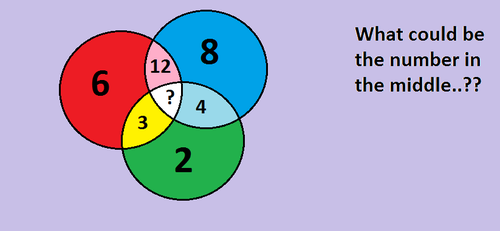Missing Link 4
 What could be the number in the middle of all circles..??
What could be the number in the middle of all circles..??
This section requires Javascript.
You are seeing this because something didn't load right. We suggest you, (a) try
refreshing the page, (b) enabling javascript if it is disabled on your browser and,
finally, (c)
loading the
non-javascript version of this page
. We're sorry about the hassle.
2 solutions
Answer could also be 12. Half of each outside circle added together would give you the intersection. By that logic, the intersection of all 3 should be 4+3+1=12.
I think you should remove the word "prime" in "prime colors".
Could this problem be solvef by set theory
ambigitious answers guess this one
If the answer in the intersection is based on multiplying the base circle numbers together and dividing by 4, then by that logic the centre number should be 2x6x8/4 = 24. Surely it's the base numbers that should be used again here not the 2-circle numbers?
observe that..
1 2 ∗ 3 mod10 =6
1 2 ∗ 4 mod10=8
3 ∗ 4 mod10= 2
therefore the missing number say x must also satisfy the conditions:
1 2 ∗ 3 ∗ x mod(10)=6
1 2 ∗ 4 ∗ x mod(10)=8
3 ∗ 4 ∗ x mod(10)=2
it is conclusive that x must end in 6 for all the above statements to be true..
therefore the only option ending in 6 is 36.
hence the answer
Even if x=1, equations are satisfied ? It will have no effect on final answer.
Log in to reply
x is any integer other than 1! because you take one then.. you get the same initial value again!
Observe that number obtained by combining two colors is derived by multiplying both color and dividing it by 4.
Example. RED has number 6 and BLUE has number 8. So PINK color is derived as (6 * 8)/4 = 12.
And same way ultimate middle number is derived by multiplying all combined colors (12 * 4 * 3)/4 = 36.